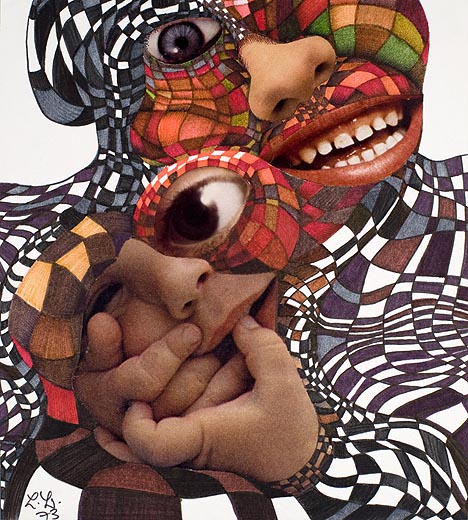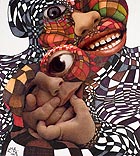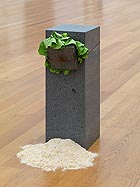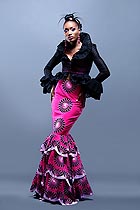
translated and summarized by: Liz Wollner-Grandville,
English summaries February 21 - March 6
MUSA – Museum auf Abruf
Lieselott Beschorner – Between Abstraction and Grotesque
01.02.11 – 12.03.11
Emotionalisms and grotesqueness
In recent years the Austrian exhibition market has rediscovered female artists. The Kunsthalle Krems presented works by Paula Modersohn-Becker for the first time, the Bawag Contemporary displayed beautiful bulky installations by Phillida Barlow, who – until then- was practically unknown outside of Britain, and the Kunstforum devoted itself to Birgit Jürgenssen.
Currently, the MUSA is displaying the exciting, contemporary, diversified and, at times, in its quality faltering, oeuvre of the Viennese artist Lieselott Beschorner. She was among the first female artists to be accepted as a member of the Vienna Secession in 1951. Yet even this “knighthood” did not keep the now 83 year-old to withdraw almost completely from the art market.
Beschorner’s early works proved to be rather conventional – landscapes and nude paintings, skilfully made but not really innovative. Her subsequent “emotional” works are committed to the aesthetics of her time, drawings in which she piles eyes and faces on top of each other; as well as collages created with torn paper. However, even more fascinating than these works, with which Beschorner definitely proves her enthusiasm for experimentation, are her eerie woollen dolls that remind of Voodoo fetish and their materiality reminding of Louise Bourgeois’s work; equally original are her surreal collages, in which photo snippets of mouths, eyes and noses float on waves in the style of Pop Art, which Beschorner described as “Grotesquenesses”. And with her “Stocking object”, entangled legs with stockings and ladies shoes, she seems to have pre-empted a subsequent concept of sculpture.
But possibly it is Beschorner’s own house that can be denoted as her most important piece of art. Walls in her house, decorated with a remarkable number of wax and button dolls, are depicted in the exhibition catalogue, as well as a closet with “spice stockings”. Lieselott Beschorner rightfully deserves her rediscovery, despite her ambivalent oeuvre.
By Nina Schedlmayer
MUSA – Museum auf Abruf
1010 Vienna, Felderstrasse 68, near the Town Hall
Tel: +43 1 4000 8400
Fax: +43 1 4000 99 8400
Email: musa@musa.at
www.musa.at
Opening hours: Tue – Fri: 11 a.m. – 6 p.m., Thu: 11 a.m. – 8 p.m., Sat: 11 a.m. – 8 p.m.
Lentos Kunstmuseum Linz
Che Fare? Arte Povera – The historical years
18.02.11 – 29.05.11
From the echo chamber of myth
Sometimes history can offer the most incredible stories, make it clear what is was like back then, and attempt to find out why it was the way it was. The Lentos Kunstmuseum is currently leafing through the brightly illuminated picture book of recent art history and narrates the dark history of the Italian-origin and Italian-biased Arte Povera of the late 60’s and early 70’s.
Something that is more than commendable for a transalpine museum – seen from the perspective of Rome- and with a view on the presumably main theme of the upcoming dOCUMENTA (13), almost visionary: with the “Idee di Pietra (views of a stone) by Giuseppe Penone on June 21, 2010, Carolyn Christov-Bakargiev, head of the dOCUMENTA already pointed in the direction of Kassel.
In “Che fare? Arte Povera – The historical years”, a production by the Kunstmuseum Liechtenstein in Vaduz, the chapter of a poor, but never pathetic art is extensively dealt with and illustrated in works ranging from A (as in Giovanni Anselmo) to Z (as in Gilberto Zori).
Among the 100 works displayed, the starting as well as the rejection points of a group of artists create an intense dialogue - arguing with social-revolutionary intent – typically 1968ers – with poetic-emotional “archetypes from the echo chamber of myth” (Hans-Joachim Müller). In an historically well secured and philosophically-lined territory (e.g. through Germano Celant or Harald Szeemann), in which Pop Art artists acting in step, together with polished and banal everyday folklore, have no place.
It is not surprising that the pictures and space objects and their naturalistic materials, which are blatantly obvious for everyday use, appear burnt out and come across in a straight, simple, directly symbolic language. After the grandiose demands of the Arte Povera for a liberalized life and risk-prone withdrawal have faded, the size and perfection of the objectification of the epic topics – energy, alchemy and existence, world, time and history – can now be pointedly perceived.
Which, on the whole, is not to their disadvantage. And this is how the as yet and over and over core-competent narrations of Arte Povera, in their search for an authentic art in an authentic life, reproduce across all generations. Something that incidentally proves the interminable character of a myth and identifies a myth as being tireless intellectual work, which, today, should lead to a museum visit. But that is another story….
By Stephan Maier
Lentos Kunstmuseum Linz
4020 Linz, Ernst-Koref-Promenade 1
Tel: +43 70 7070 36 00
Email: info@lentos.at
www.lentos.at
Opening hours: Daily except Tuesdays, 10 a.m. – 6 p.m., Thu 10 a.m. – 10 p.m.
Krinzinger Projekte
Razvan Botis – Trying to purchase what I once wanted to forget
15.01.11 – 26.03.11
Odd dough
There are two types of distress one can encounter when involved with consumption: an empty wallet or a forgotten PIN code. Someone who is broke or has lost access to his/her money is excluded from the warm and happy feeling of being able to buy something.
The writing on the wall of the exhibition of the young Romanian artist Razvan Botis reads: „The warmer, the cosier“, which sounds more like a promise that reproduction rates could increase this summer. Or one could conclude that the City of Vienna is funding the heating costs to ensure social stability. The coal particles, with which the writing on the wall was carried out, were carefully blurred beyond the outlines of the letters, as if they were caressed into the white of the wall, and this tenderness is possibly characteristic to all works displayed. The eponymous photograph shows a crude glove on a card reader. The empty hull arches protectively and inept over the blue plastic – the encounter of the neutral paying station with the lost, singular protective cover of a now freezing hand discloses an odd moment between anonymous embarrassment and personalized diligence. The other work, in which money drastically claims its right, despite its absence, shows three wallets on a crude wooden panel on two supports. The purses are new, empty and therefore flat, until they open and close like a clam – this piece is called “Breathing lessons”. A stranded fish could never be as amusing and at the same time look as endearing and silly.
Two works with swords appear more cryptic; one, near the ground on a white base is called “Don’t trust the colours”. Sample leather stripes in various colours have been spiked in an elegant way: an analogy with shish kebab sticks would be nasty, and the question who should have mistrusted whom, but who was committed and involved, still needs to be interpreted. The other sword, mounted solitarily and horizontally on the wall, fits perfectly into the wide end of a tie, as if it were a custom-made sheath. Rarely was scepticism against virile commotion presented in a more succinct manner.
None of the pieces refers to a dogma or claims any politically correct gestures of concern. They all share an astonished form of touching and questioning – of those things we know, of those which might hassle us, of those which we might prefer not to notice and those which we know through Razvan Boti’s arrangement, suddenly releases cheerful irony. The exhibition has been prolonged until March 26 and a catalogue documentation is currently in progress.
By Gesche Heumann
Krinzinger Projekte
1070 Vienna, Schottenfeldgasse 45
Tel: +43 1 512 81 42
Email: krinzingerprojekte@gmx.at
www.galerie-galerie.at/projekte/
Museum für Völkerkunde
African Lace – Austrian Fabrics for Nigeria
22.10.10 – 14.03.11
Before: Afterwards – and thereafter
Last minute offer: fortunately the exhibition was prolonged until March 14 and more viewers are given the opportunity to discover an amazingly-fabulous-bizarre-picturesque chapter of fashion at the Völkerkundemuseum in Vienna. Since the early 1960’s embroidery from Vorarlberg has been exported to Nigeria and, known as „African Lace“, made fashion history. The exhibition intends to present the country from its best side – while in the past 50 years, since its independence from Great Britain, Nigeria usually only hit international headlines due to violent conflicts and famines.
Before
Magnificently embroidered, traditional robes – generously tailored shirts, worn loosely over the shoulder, and hand-woven fabrics with traditional patterns, form the first part of the exhibition. According to Yoruba-researcher Reverend Samuel Johnson's description dating back to the end of the 19th century "men wear robes, undershirts and wide trousers, called Sokoto. (…) while the women’s clothing is much simpler. It consists of two or three wraparounds and a headdress", In contrast, it is fascinating to see a woman’s costume from the Bregenzerwald. It seems a corollary that these embroidery styles crossed each other at some point….
Afterwards
To this day, the traditional Nigerian cuts were retained, respectively new designs were made for plain, simple shirt and blouse forms – but the artfully patterned lace fabrics added a new flair. Fashion consciousness and a weakness for exotic fabrics (from Europe or India) has been attested to the Yoruba already from the beginnings of maritime trading in the 16th century; and by the end of the 19th century – following the colonisation in 1861 – high-ranking trendsetters adopted western style elements. Spectacular patterns on wax fashion fabrics and the first Swiss and Vorarlberg lace cloth found their way to West Africa. This “one-way” situation with the producers from Vorarlberg changed at the beginning of the 1970’s. From that day, the diverse floral and abstract patterns as well as the colour schemes were subtly adapted to fit the customers’ taste and, if need be, were jointly developed. It was therefore not unusual to repeatedly find a Mercedes star, a Rolls Royce logo, or that of other automobiles, ladies sandals, crowns or Tyrolean hats printed on the fabrics.
The subtitle of the catalogue - African Lace. A history of trading, creativity and Nigerian fashion – deals with this topic in detail and documents the exhibition emphases: selected creations by the most renowned Nigerian fashion designers, high society’s fashionable ensembles and their overhanging head scarves “Gele”, Sascha Reichstein’s artistic film project and insights into the work processes of the manufacturing sites in Vorarlberg, and the “golden years” of the trade relations.
And what will follow?
It is unrealistic to think that the unlimited boom will continue: the Vorarlberg producers have come under severe price and demand pressure due to the financial crisis and the replicas, respectively the Chinese plagiarisms. Nevertheless, one relies on customer loyalty - after all, they do not want to miss out on the luxury of first class quality.
By Aurelia Jurtschitsch
Museum für Völkerkunde
1010 Vienna, Neue Burg
Tel: +43 1 525 24 404
Fax: +43 1 525 24 371
email: info@ethno-museum.ac.at
www.ethno-museum.ac.at
Opening hours: Daily except Tuesdays 10 a.m. - 6 p.m.
Mehr Texte von translated and summarized by: Liz Wollner-Grandville


 Teilen
Teilen





